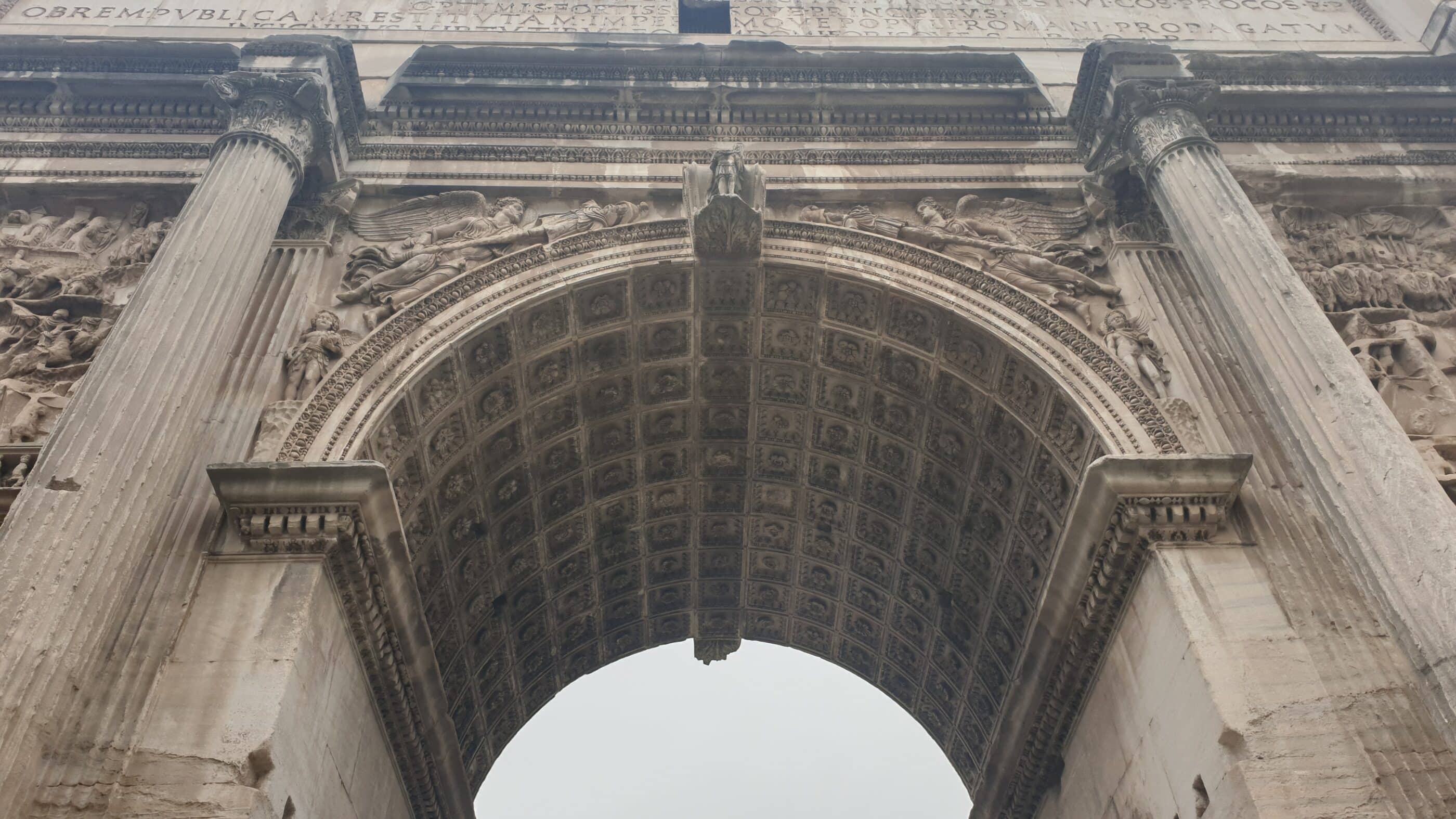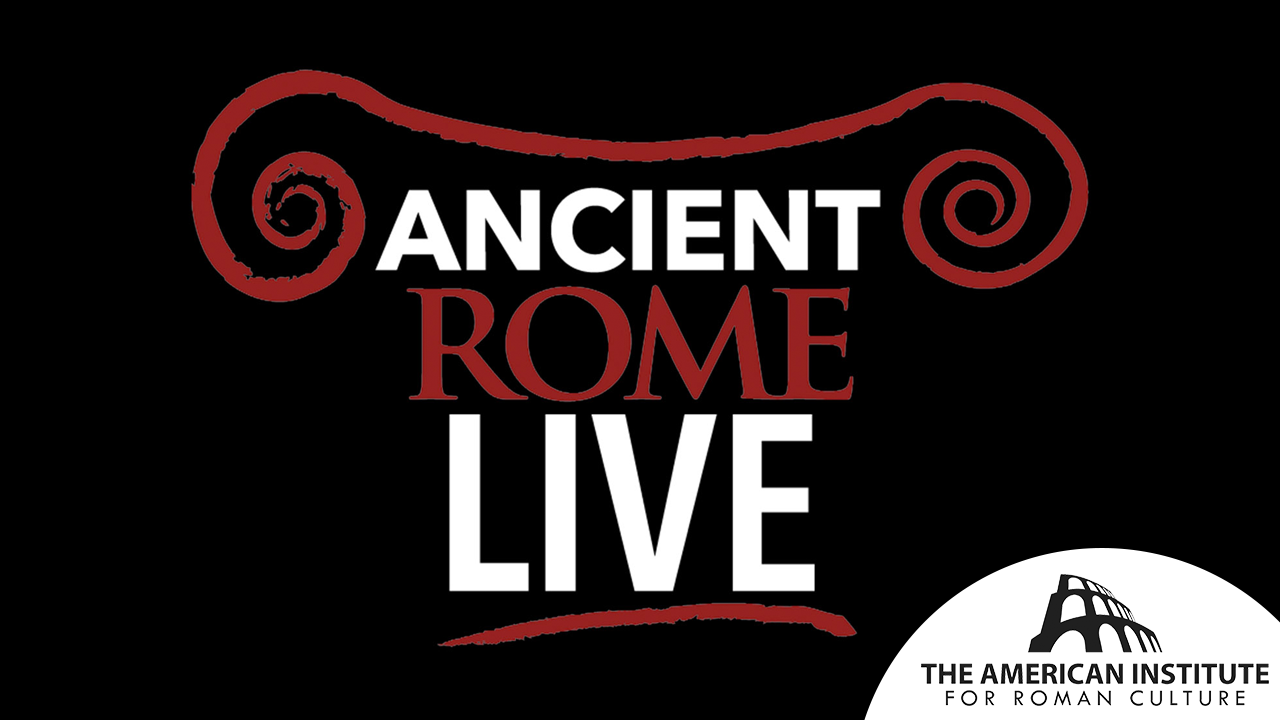Start with our video overview:
The Arch of Septimius Severus is a monumental triumphal arch located in the Roman Forum. It sits at the foot of the Capitoline Hill along the Via Sacra, the route taken by victorious generals during triumphal processions. The arch was built in 203 CE to honor Emperor Septimius Severus and his two sons, Caracalla and Geta, for their military victories over the Parthian Empire. These campaigns, fought between 194-195 CE and 197-199 CE, resulted in the annexation of parts of northern Mesopotamia into the Roman Empire.
The arch has three passageways, with the central and largest arch serving as a road through the structure. The exterior is covered in Proconnesian marble, though much of the base and interior were built using travertine. Eight free-standing columns with composite capitals decorate the façade, along with carved reliefs that celebrate the emperor’s military achievement and divine favor.
These reliefs depict scenes from the Parthian campaigns, including soldiers in battle, spoils of war, and prisoners being captured. Winged victories hold trophies, and mythological figures such as Mars, Hercules, and Bacchus appear as well. The arch was originally topped with gilded statues, now lost. Based on ancient coins, these statues likely showed Septimius Severus in a six-horse chariot, flanked by his sons and attendants.
After Septimius Severus died in 211 CE, his sons Caracalla and Geta briefly ruled as co-emperors. However, in 212 CE, Caracalla had Geta murdered and launched a campaign to erase his memory from public life (damnatio memoriae). As a result, Geta’s name and images were removed from monuments throughout the empire, including the Arch of Septimius Severus.
The arch also contains a hidden staircase built into its left pier, which leads to a concrete chamber in the upper section of the arch. From there, it is possible to access the cornices and the roof. In the Middle Ages, this feature led to the arch being used as a watchtower and fortress. Evidence of medieval occupation remains visible, including inscriptions left by craftsmen and stonemasons who once lived or worked there.
Despite centuries of change, the Arch of Septimius Severus remains one of the most impressive and best-preserved monuments in the Roman Forum, offering insights into Rome’s imperial power, military achievements, and political struggles.
Bibliography
- Barnes, T. D. (1967). “The Family and Career of Septimius Severus.” Historia: Zeitschrift Für Alte Geschichte, 16(1), 87–107. http://www.jstor.org/stable/4434969
- Brilliant, Richard. (1967). “The Arch of Septimius Severus in the Roman Forum.” Memoirs of the American Academy in Rome, 29, 5–271. https://www.jstor.org/stable/4238659
- Claridge, Amanda. (1998). “Rome.” Oxford University Press.
- Grout, James. “The Arch of Septimius Severus.” University of Chicago. https://penelope.uchicago.edu/encyclopaedia_romana/romanforum/archseverus.html
- Platner, Samuel. (1929). “Arcus Septimii Severi.” In A Topographical Dictionary of Ancient Rome (p.43-44). Retrieved from: https://penelope.uchicago.edu/Thayer/E/Gazetteer/Places/Europe/Italy/Lazio/Roma/Rome/_Texts/PLATOP*/Arcus_Septimii_Severi.html
Arcus Septimi Severi (in foro Boario), Arcus Argentariorum or Monumentum Argentariorum: modern names given to an arch, which probably served as an entrance to the Forum Boarium (q.v.), that stands at the south-west angle of the church of S. Giorgio in Velabro, the campanile resting partly upon one pier of the arch and concealing two of its sides.
Read more:
It was erected in 204 A.D. by the argentarii et negotiantes boarii huius loci qui invehent, in honour of Septimius Severus, his wife, his sons Caracalla and Geta, and Caracalla’s wife Fulvia Plautilla, the daughter of Plautianus (CIL VI.1035; cf. 31232). The inscription seems to have been modified thrice — after the fall of Plautianus in 205, after the murder of Plautilla in 211, and after the murder of Geta in 212.
The arch is not a true arch, but a flat lintel resting on two piers, and is entirely of marble, except the base, which is of travertine. It is 6.15 metres in height and the archway is 3.30 metres wide. At the corners of the piers are pilasters with Corinthian capitals, and the whole exterior surface is adorned either with coarse decorative sculpture or reliefs representing sacrificial scenes. On the inside the figures of the imperial family are carved in relief (those of Plautilla and Geta have been removed); the ceiling is cut in soffits, and the inscription is on the lintel (Bull. d. Inst. 1867, 217; Jord. I.2.470; PAS II.70; LS III.42; Mél. 1924, 111‑150; Fiechter and Hülsen ap. Töbelmann I.88‑96; SScR 305; Reinach, Rép. des Reliefs, I.271‑272).
This content is brought to you by The American Institute for Roman Culture, a 501(C)3 US Non-Profit Organization.
Please support our mission to aid learning and understanding of ancient Rome through free-to-access content by donating today.
Cite This Page
Cite this page as: Darius Arya, The American Institute for Roman Culture, “Arcus Septimius Severus (Arch of Septimius Severus)” Ancient Rome Live. Last modified 07/26/2025. https://ancientromelive.org/arcus-septimius-severus-arch-of-septimius-severus/
License
Created by The American Institute of Roman Culture, published on 07/26/2025 under the following license: Creative Commons: Attribution-NonCommercial-ShareAlike. This license lets others remix, tweak, and build upon this content non-commercially, as long as they credit the author and license their new creations under the identical terms. Please note that content linked from this page may have different licensing terms.




